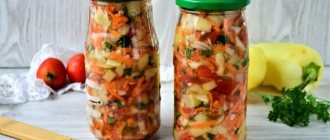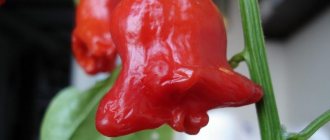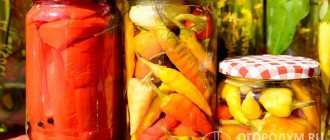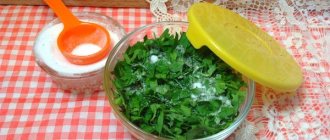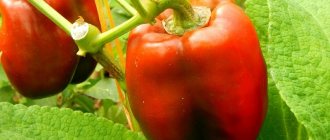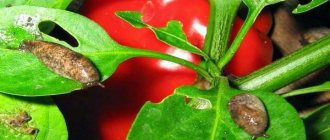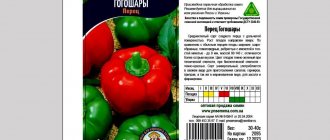During the cold season, snacks or pickles made from vegetables and fruits come in very handy. Tomatoes, cucumbers, eggplants, mushrooms are familiar products on the table, but few people have cooked tsitsak pepper according to the original recipe of Armenian cuisine or even tried it.
Tasty and aromatic peppers will always look great on the holiday table and go well with meat, pilaf and other dishes. Tsitsak is a pepper that is yellow or green in color, long in shape and spicy. The result of cooking is a very tasty pickled or salted, pickled pepper, which is not even rolled up under the lids. Barrels are a classic place to store the product, which adds even more atmosphere and the desire to prepare this snack for the winter.
Features of growing Tsitsak hot pepper seedlings
Hot pepper Tsitsak: video about the variety
To grow a good harvest of Tsitsak peppers, you just need to follow a few basic rules.
To begin with, it is important to choose the right Tsitsak pepper seeds and process them. Testing the germination of pepper seeds is not much different from other vegetables. This procedure is also called calibration; it is used to reject barren flowers
This procedure is also called calibration; with its help, barren flowers are rejected.
Tsitsak pepper seeds are immersed in salt water for a couple of hours. Those that float to the surface are thrown away. It should be noted that there is practically no 100% germination of Tsitsak pepper seeds.
To disinfect selected seeds, dissolve half a teaspoon of wood ash in a liter of water, leave for about a day, not forgetting to stir the solution periodically. Seeds placed in gauze cloth are immersed in the prepared solution for a couple of hours. After this time, the seeds of the Tsitsak hot pepper are carefully washed and dried. Instead of an ash solution, pepper seeds can be dipped into a manganese solution for about twenty minutes, for the preparation of which 10 g of manganese are diluted in one and a half liters of liquid.
Soil suitable for sowing Tsitsak hot pepper for seedlings is sold in specialized garden centers, and experienced gardeners prefer to compose the soil themselves, especially since it does not present any difficulties. Soil components include soil, humus, sand and turf. All components are taken in equal parts. In addition, per 10 kg of such soil, at least half a kilogram of wood ash is added. You can also add potassium sulfate and superphosphate to the prepared mixture.
It is important to take your time and thoroughly mix all the ingredients to prevent possible burns to very vulnerable sprouts that will hatch from the seeds.
As a rule, Tsitsak pepper seeds are sown in late February or early March. Seedling containers are filled with soil and grooves are made, no more than one centimeter deep. The furrows are watered so that the seeds fall into moist soil and there is no need to water them abundantly after sowing, since then they can simply move into one heap. Next, the Tsitsak pepper seeds are carefully distributed in the grooves and sprinkled with soil. The crops are slightly moistened using a regular spray bottle, covered with film or glass and left in a room with a temperature not lower than +23... +25 degrees.
Proper care of seedlings is very important, since diseases that affect young shoots are largely due to errors made in care. For example, many people place seedling containers on window sills, since in winter this is the most lit place. This is certainly true, but in winter the glass blows cold and, as a result, the soil temperature drops below the permissible level, and the seedlings stop growing and developing.
- Also, you need to monitor the level of soil moisture, avoiding drying out or waterlogging. In addition, it is better to use water at room temperature for irrigation.
- In order to prevent various diseases that affect seedlings, it is recommended to water the seedlings with a solution of a biological fungicide once every two weeks.
- Also, before germination, it is recommended to ventilate the crops by removing the shelter for several hours.
- Seedlings are picked when the plant already has 2-3 true leaves. Plants are planted very carefully, together with a lump of earth, trying not to damage the fragile roots. Otherwise, the seedlings will get sick and take a long time to adapt, which will consequently affect their development and growth.
- After picking the seedlings, fertilizer should be applied. Having received useful nutrients, the seedlings will take root faster and easier. Fertilizing is done using potassium phosphate fertilizers.
Pepper Tsitsak: photo of the variety
Tips and tricks
Some useful tips that will make the cooking process easier and help make the dish more delicious:
- If fresh fruits are not available for pickling, it is permissible to use dried ones.
- Honey should be chosen natural. Otherwise, it may “boil” and ruin the entire dish.
- The seeds make the brine more pungent and bitter. If you want to reduce this effect, remove the seeds immediately after washing the peppers.
- In traditional Caucasian cuisine, peppers are usually dried in the sun for 2-3 days before pickling.
- If you work with large quantities of pepper, protect your hands and nasopharyngeal mucosa. Regular silicone gloves and a respirator will do.
Fried chili in marinade - an especially tasty recipe
Canned hot peppers for the winter are an excellent preparation and an ideal addition to any fish and meat dishes. Moreover, the process of preparing it will not take you much time, and its taste will pleasantly please you with its light spice in combination with the sweet and sour marinade. However, before analyzing any recipes for preparing fried chili, let’s study the main features, without which preparation is impossible:
When considering canned chili recipes, try to focus on choosing meaty varieties. Combine colors by choosing multi-colored pods. To make the pepper more rich in taste and not lose its aroma, experienced housewives advise frying it whole, without removing the seeds or the tails. It is necessary to fry hot peppers in a large amount of vegetable oil. However, many recipes say that it would be healthier to first bake it in the oven and then fry it in a frying pan. Freshly roasted chili perfectly absorbs aromas and is well saturated with all flavor shades.
Therefore, the ideal combination in this case would be a marinade made from a mixture of honey, garlic, herbs and vinegar.
To prepare fried hot peppers you will need:
- hot pepper (chili) – 15 pcs.;
- sugar or honey (can be combined) – 4-5 tbsp. l.;
- table vinegar 9% – 70-100 ml;
- garlic – 1 head;
- parsley – 1 small bunch;
- vegetable oil - for frying.
Preparing Roasted Hot Peppers
We begin canning directly by frying the peppers. To do this, you need to heat the vegetable or olive oil well enough. However, do not wish for butter. In the meantime, while the oil is heating up, without wasting any time, let’s start preparing. Wash the vegetables thoroughly, cut off the tails, leaving one and a half to two centimeters so that it is convenient to remove them from the jar, wipe the pepper from any remaining water and pierce it with the tip of a knife along the entire perimeter. This is necessary to prevent the chili from cracking during frying under excess steam pressure.
Having finished preparing, put the hot peppers in a frying pan and fry them on both sides until a golden brown crust appears, and then for just a couple of minutes under the lid over low heat. If desired, the chili can be grilled. It will be much tastier and healthier this way. However, before doing this, do not forget to coat the pepper in a sufficient amount of vegetable oil. Let's give the peppers time to rest, but for now let's prepare the sweet and sour preparation. To do this, add a mixture of honey and sugar to the remaining oil after frying.
We peel the head of garlic and chop the cloves finely with a knife or pass them through a garlic press and chop the greens. We add this aromatic mixture to our sweet dressing, mix everything, let the dressing cool, and then pour in 9% vinegar. Pour the resulting garlic-oil mixture with honey over the roasted chili and leave it to steep in the refrigerator for a day. If desired, you can immediately put the peppers in jars and pour the marinade over them. If, after you have poured the marinade, there is not enough of it, add the required amount of boiled water. Despite other recipes that use hot marinade, it is preferable to use cold marinade here. Now just roll up the lids on the jars and safely send them to the pantry.
Tsitsak in oil
Hot pepper in oil has a pleasant spicy taste without excessive heat and an appetizing aroma. This twist can be eaten as a separate appetizer or as a side dish to other dishes. Required:
- hot capsicums – 800–900 g;
- olive or sunflower oil – 130 ml;
- table vinegar 6% – 400 ml, sugar – 1 tbsp. l;
- bay leaf – 3–4 pcs., garlic cloves – 6–7 pcs.;
- cilantro and parsley - a bunch each, salt - 2 tbsp. l.
Preparation of tsitsak pepper:
- Prepare a marinade from vegetable oil, granulated sugar, vinegar, salt and bay leaves. Place the pan over medium heat and bring to a boil.
- Then add the legumes to the marinade and boil for 7–8 minutes. As soon as they change color, they can be removed from the pan. Set aside in a sieve to drain.
- After this, you need to add to the marinade: chopped parsley and cilantro, garlic cloves, cut into thin slices.
- Bring to a boil again and simmer for 3-5 minutes. Peppers should be packaged in sterilized jars and pour boiling marinade over them. Close with lids and leave to cool.
The recipe for Armenian pepper tsitsak is a real find for lovers of spicy, spicy snacks. It is very tasty as an independent dish. Goes great with meat, cereals and potatoes. By experimenting with different ingredients, you can prepare an original winter preparation with an unusual, bright taste.
How to cook tsitsak pepper for the winter
To prepare pickled or salted vegetables, it is best to take oblong, thin, yellowish-green fruits. There is no need to remove the seed inside and the stalk. Before preparing pickled peppers, the pods need to be dried a little: spread the unwashed vegetables on the windowsill for 2-3 days, covered with gauze. Fruits should be washed immediately before cooking.
Important! To prepare whole pickled vegetables, you need to use fruits no longer than 8 cm. If the pods are larger, they are cut into rings. If the fruits are too bitter, you can soak them in cool water for 12-48 hours, refreshing it periodically
If the fruits are too bitter, you can soak them in cool water for 12-48 hours, refreshing it periodically.
Before pickling or salting, each fruit must be pierced with a fork or knife in several places so that the air comes out of them and they are better saturated with the marinade.
For salting, it is better to use rock or coarse sea salt.
Before cooking, it is better to get rubber gloves and a respirator to protect your hands and nasal mucosa from burns.
Advice! If the fruits are very bitter, they should be scalded with boiling water or soaked in water for a day or two.
Pickled vegetables are usually used as an addition to meat and fish dishes, vegetable salads, but for lovers of spicy and piquant foods, pickled snacks are suitable as an independent dish.
Benefits and contraindications of pepper
It’s hard to imagine many vegetable and meat dishes, soups, and salads without pepper. The fruits have a high vitamin C content, much more than lemon and black currant. The fruits contain plenty of iron, phosphorus, beta-carotene, coumarin scopoletin, and essential oils. The pungency of the fruit is due to the presence of the alkaloid capsaicin.
The hot vegetable is useful for people with:
- myopia;
- atherosclerosis;
- respiratory diseases;
- heart failure;
- obesity.
Those who prefer spicy food with the addition of pepper are always in a good mood. The happiness hormone in the pods increases stress resistance and strengthens the immune system.
Among the contraindications of the product are diseases of the gastrointestinal tract and liver. Excessive consumption of spicy fruits is harmful to elderly people with hypertension. People with allergies and women who are pregnant or breastfeeding should not use them.
Pickled hot peppers for the winter without sterilization
Any pepper, red or green, is suitable for cooking. It is better to choose thinner pods, as they will marinate faster and are beautiful without damage.
If the pods are very long, you can cut them into pieces. This pepper is suitable for any meat dishes.
You will need:
For 1 liter jar
- 300 gr. – hot hot pepper
- 2 tbsp. spoons - coarse salt
- 3 tbsp. spoons - sugar
- 100 ml. – table vinegar
- Clean cold water
- 2-3 pcs. – bay leaves
- 5-6 pcs. – black peppercorns (you can also add allspice, mustard seeds, cloves)
- Greens (dill, parsley) – to your taste
How to cook:
1. Wash the jars and put all the spices at the bottom of each.
2. Wash the peppers, cut off the dry ends, if necessary, and put them in a jar (you don’t have to cut off the tails; it’s more convenient to take the peppers by the tail when tasting) to the very top.
On a note! If there is not enough hot pepper, you can add bell pepper (just cut it into thin slices). It will marinate and turn out no less tasty than spicy!
3. Pour hot water over the peppers and leave for 30 minutes. Then pour the water into a separate pan or bowl, add salt and sugar, bring to a boil and pour back into the jars.
4. After 5-10 minutes, pour the water back into the pan, add vinegar and pour it into the jars again. Pour the marinade to the very edge of the neck so that it pours straight out!
5. Now you can roll it up.
Calorie content of pickled hot pepper per 100 g. – 33 kcal.
Bon appetit!
On a note! If you don’t want to get VERY hot peppers, you can first soak them in hot water for 10 minutes or in cold water for a day (the water needs to be changed periodically). This way the sharpness and bitterness will partially go away.
I recommend reading:
Hot chili pepper: composition, calorie content, daily dosage, benefits and harms
Quick recipe
Recipes for making tsitsak pepper can be as easy and simple as possible. This method is ideal for pickling hot fruits in small 0.5 liter jars. This volume is quite enough for a small family. Products you need to prepare:
- capsicums – 500 g;
- allspice – 5–6 peas;
- sugar – 5 tbsp. l, salt - 2 tbsp. l;
- table vinegar - 7 tbsp. l.
Cooking steps:
- The washed peppers should be compacted tightly into prepared glass jars.
- Pour boiling water over and leave for 15 minutes. Pour water from cans into a saucepan.
- Add salt, granulated sugar and spices, simmer for 8-10 minutes.
- After this, add vinegar to the marinade and pour in the tsitsak. Seal the jars with tin lids.
Georgian marinated hot peppers
Georgian cuisine involves a variety of snacks with spices and aromatic seasonings, so pickled peppers are found in almost every home. Georgians know how to cook it correctly, so that the fruits are not only piquant in taste, but also soft with a subtle, pleasant aroma.
Compound:
- 2 kg pepper;
- a bunch of celery;
- a bunch of parsley (you can use cilantro);
- 5 bay leaves;
- 3 garlic cloves;
- 250 ml vegetable oil;
- 3 tbsp. salt;
- 3 tbsp. Sahara;
- 2 cups apple cider vinegar.
How to cook:
Cut the washed pods slightly at the base with a sharp knife so that the brine can penetrate inside. Prepare the marinade: mix water with vegetable oil in a saucepan, add salt and pepper to the liquid, then bring to a boil, keep on medium heat for 2-3 minutes, pour in vinegar and add bay leaves. Do not turn off the heat.
Place the peppers in boiling brine and cook for 5-6 minutes
Periodically use a slotted spoon to turn them over and stir, but only carefully so as not to damage them. Then remove the pods, place them in a colander and let the marinade drain
Place the pan with the marinade back on the stove. While its contents are heating, chop the herbs, then transfer the fragrant herb to the marinade and let everything simmer for 2-3 minutes.
Place the peppers tightly in sterilized glass jars and fill them with hot marinating mixture to the very edges so that no air remains. Leave the snack to cool at room temperature. Georgian hot pepper goes well with other national dishes. It is often served with lobio, stewed pork, lamb and beef. The appetizer can be added to soups and pilaf.
On a note!
To prevent the appetizer from turning out too spicy, do not remove the skin from the garlic cloves, marinate directly in it.
Classic recipe
How to cook tsitsak peppers? To do this, you can use the classic recipe, which has gained popularity far beyond the Caucasus. Required products (per 1 l):
- capsicums – 1 kg;
- garlic cloves – 3–4 pcs.;
- fresh dill – 30 g;
- salt – 3 tbsp. l, water – 2 l.
Hot pepper tsitsak is prepared as follows:
- The peppers need to be washed and dried with a paper towel. Finely chop the dill, peel the garlic cloves and cut into thin slices.
- Place dill, garlic and peppers in layers in a large saucepan. Next, you need to cook a brine from 2 tablespoons of salt and water (1 liter), leave it to cool.
- After this, you need to pour the brine over the fruits and cover with a lid. Press under pressure and leave to marinate for 10–14 days. It should turn yellow.
- Prepared vegetables should be compacted into glass jars. Pour boiling brine consisting of 1 liter of water and a spoon of rock salt.
- Jars containing the product must be sterilized. Place a napkin folded several times on the bottom of a wide pan. Place the containers and sterilize for 10 minutes.
- Screw on the tin lids. Cover the jars with a blanket or warm terry towel until they cool completely.
Features of care
The planted crop needs to be fed with nitrogen mixtures. After each pepper stem grows 3 leaves, potassium and phosphorus fertilizers must be added to the soil.
To speed up the growth of the bush, it should also be fed with organic matter. The best option is a mixture based on wood ash. Fertilizers are applied approximately 1-2 times every week.
Tsitsak peppers need to be watered depending on the climate. The soil should not dry out too much, but you should not allow it to become waterlogged either. The approximate number of waterings is 2-3 weekly. To moisten 1 square meter, 0.6-0.8 liters of liquid is enough. It is better to water the crop in the late evening or early morning.
In addition, experts especially note the importance of timely cutting of fruits, which can not only deteriorate themselves, but also cause rotting of the plant’s root system. https://www.youtube.com/embed/B7MsNopWo_E. https://www.youtube.com/embed/B7MsNopWo_E
Terms and conditions of storage
Storage conditions for Georgian pepper are no different from other pickled vegetables.
Important Rules:
- Do not keep near heating devices or in places with temperature changes. The kitchen, for example, is completely unsuitable for this.
- It is advisable to store jars in the refrigerator. Especially if they are not rolled up.
- Do not place the seams on the balcony at sub-zero temperatures. This will cause them to leak.
- Periodically check the jars for cloudiness of the brine or the appearance of spots on the fruit. Such preparations cannot be eaten.
Shelf life varies depending on the preparation method . One way or another, all the preparations given in the article will definitely remain fresh until winter. The shelf life increases when adding a large amount of salt, vinegar or after sterilizing already filled jars.
also important to boil jars and lids before starting cooking .
Characteristics and secrets of growing “Tsitsak” - semi-hot pepper with a delicious taste
Having received its name in honor of the Armenian national dish, the hot pepper “Tsitsak”, according to experts, is the best variety recommended for pickling. Photos, characteristics of the variety and a description of the key points of cultivation will be of interest to those who would like to grow it on their site.
Folk variety of hot pepper: description of characteristics
The “Tsitsak” variety is a special variety of hot pepper, which appeared as a result of folk selection and is very popular in Armenian and Georgian cuisine, where it is salted and fermented.
Attention! The heat index of the Tsitsak pepper can vary between 1500-3500 SHU. Characteristics of this vegetable:. Characteristics of this vegetable:
Characteristics of this vegetable:
- heat-loving, like all peppers, therefore in temperate and northern regions we recommend for growing under film covers and in greenhouses, in the southern regions - in open ground;
- productive, undemanding to lack of sunlight;
- medium-leafed bush with a strong stem reaches a height of 60-80 cm;
- has an average ripening period, fruits reach technical maturity in 100-110 days;
- fruit shape – pointed, elongated, pepper size – from 13 to 20-23 cm;
- technically ripe peppers have a light green color, biologically ripe ones have a red color;
- the fleshy pulp has a medium level of pungency with a pronounced sweetish note;
- recommended for use fresh, pickled, salted and pickled.
“Tsitsak” pepper is especially valued in Armenian and Georgian cuisine
How to grow Tsitsak pepper
To obtain strong and high-quality pepper seedlings, pre-treated and hatched seeds are sown in boxes with nutritious soil in February-March. The seeding depth is 0.5 cm. The seeds are sprinkled with soil on top.
Advice. For peppers of the Tsitsak variety, it is recommended to choose a soil mixture consisting of turf and rotted compost, taken in a 2:1 ratio.
To speed up seed germination, it is recommended to cover the crops with spandbond, agro-fabric or regular film and provide them with a flexible temperature regime:
- during the daytime - +23-25°C;
- at night - +13-15°C.
Peppers are grown using seedlings.
As soon as the first 1-2 true leaves appear on the seedlings, the Tsitsaka seedlings should be planted in separate peat cups
Picking should be done carefully so as not to damage the fragile roots of the peppers.
2 weeks after picking, the seedlings can be fed with special complex fertilizers or an infusion of wood ash prepared from 2 tablespoons. spoons of ash and 3 liters of water.
When pepper seedlings reach the age of 60-70 days, they can be planted in a permanent place - in a greenhouse, hotbed, or vegetable garden.
Fruit weight - about 20 grams
Pepper “Tsitsak” can be planted in 2 ways:
- square-cluster, planting pattern - 50×50 cm;
- private, planting pattern – 25×50 cm.
It is recommended to mulch the beds after planting to retain moisture in the soil, avoid loosening, and protect from weeds.
Harvesting the fruits of the “Tsitsak” pepper variety is carried out in 2 steps:
- in the phase of technical ripeness;
- in the phase of biological ripeness.
Attention! The average yield of Tsitsak pepper is 2-4 kg per 1 m², fruit weight is 15-25 g. From 1 sq.m. you can collect up to 4 kg of peppers
you can collect up to 4 kg of peppers
From 1 sq.m. you can collect up to 4 kg of peppers
Zoya Pavlovna, Taganrog: “Excellent semi-hot pepper. I got the seeds by chance and planted them a little late - almost at the end of March. 4 out of 5 seeds sprouted.
Since I immediately planted them in separate cups, I didn’t have to dive. At the beginning of June I transplanted them into the beds, and at the end of July I harvested them. From 4 bushes we got 63 light green peppers.
I left a few pieces for seeds and salted the rest - it turned out very tasty.”
Sergey Borisovich, Moscow: “I tried tsitsak pickles in Tbilisi, I liked them so much that I was inspired to grow this pepper in my dacha.
I bought seeds online and first planted them as seedlings, and then transplanted the seedlings into beds under film. The variety proved to be productive, despite the cool summer and lack of sun.
The pepper has an amazing taste, not just spicy, but with some sweetness. They ate it fresh, added it to meat, and even fermented it a little.”
Pepper "Tsitsak" ripens on average in 100-110 days
As reviews from gardeners growing this variety show, the agricultural technology for cultivating Tsitsak pepper is no more complicated than other varieties of hot pepper. Its cultivation in greenhouses and on personal plots allows you to get a good harvest of gourmet peppers, and use it for preparing vegetable and meat dishes.
Cooking tips
Before pickling tsitsak peppers for the winter, read some recommendations from experienced housewives:
- choose long pods that have reached “milk” (technical) ripeness, greenish-yellow in color - they already have thin and delicate skin, and the fruits themselves have a milder taste than mature red ones;
- Before cooking, leave the unwashed pods on the windowsill, covered with gauze or a paper towel, for 2-3 days so that the fruits wilt a little. Wash the pods immediately before cooking;
- if you come across too bitter peppers, first soak them in cold water for 12-48 hours, changing the water 3-4 times a day;
- Do not cut off the stalks completely and do not remove seeds from the pods. The prepared fruits need to be pierced with a sharp thin knife or fork in several places - this way they will be better saturated with the marinade;
- When preparing and processing raw materials, be sure to wear gloves to avoid unpleasant consequences and burns to the mucous membrane.
In Armenia and Georgia, almost every housewife prepares tsitsak. This pepper stimulates appetite and improves digestion. In reasonable quantities it can be consumed without fear.
For flavor, various spices are added to brines and marinades: dill, celery, parsley, cilantro, coriander seeds, allspice, garlic and bay leaf . You can add cherry and horseradish leaves. If you pickle the pods coldly, do not add currant leaves - they provoke mold. It is best to take coarse salt - stone (it will make the brine a little cloudy) or sea salt. Iodized salt is not suitable for preparations.
Canned tsitsak can be used in winter to prepare original savory snacks: stuff the pickled pods with brine or soft cheese, which softens the spiciness and favorably sets off the taste of hot peppers. This treat is very popular in the Balkans.
Tsitsak “Armenian style”: pickled
Let's start with the classic Armenian recipe for delicious salted pepper. For fermentation, you can use enamel dishes, wooden barrels (cedar, oak) and glass containers. Using the same principle, you can ferment another pepper - bell pepper or moderately hot chili.
Volume: 4 l
Ingredients:
- tsitsak – 5 kg;
- purified water – 5 l;
- garlic – 3 heads;
- bay leaf – 10 pcs.;
- allspice, peas - 2 tbsp. l.;
- salt – 250 g.
Preparation:
- Wash the wilted tsitsak and pierce it with a fork or toothpick in several places.
- Peel the garlic and cut the cloves in half.
- Pour salt into a saucepan with water and mix thoroughly until completely dissolved.
- Place the pods in the prepared container in layers, laying each layer with garlic, bay leaf and peppercorns. Tamp down well and fill with cold brine.
- Cover with a flat plate of suitable diameter and place pressure on it so that the entire pepper is covered with liquid. Cover the top with a lid or gauze to protect the product from dust and insects.
- Leave for at least 5-7 days (if the room is not hot, then 10-14). When the fruits turn yellow, they are ready. Drain the brine, place the pods in a colander and squeeze thoroughly to remove any remaining liquid.
- Sterilize jars and lids.
- Place the pods in jars, pressing tightly (the released liquid must be drained). Cover the jars with lids and pasteurize for 10-12 minutes (for 1-liter containers). Roll up and store in a cool place.
If you want to seal the peppers in the pot, then prepare a new brine (4 tablespoons of salt per 1 liter of water), boil and pour the hot brine over the vegetables in the jars. Roll up the lids, cool and store.
Methods for preparing hot pepper in Georgian
There are several ways to prepare hot pods in a marinade for the winter. Can:
- just pour the marinade over the pods;
- prepare the product with sterilization or not;
- fry the pepper before marinating;
- add honey to the jar with tsitsak;
- ferment spicy fruits.
All canned food based on spicy tsitsak are original and will decorate any table, giving it sophistication and uplifting the mood.
Classic recipe
To prepare peppers marinated for the winter according to the Georgian recipe, you need to take per liter of water:
- several red and green pods with a total weight of 100 grams;
- a few peas of allspice;
- salt 1 tablespoon;
- 2 tablespoons of sugar;
- vinegar 50 milliliters;
- water about 1 liter.
For the fruits you will need a glass jar of 70 or 100 milliliters. The container must be thoroughly washed and scalded with boiling water. Place the pods tightly and pour boiling water over them. After holding for 5-10 minutes, the water is drained. Now it’s time to add the ingredients for the marinade: sweet peas, sugar and salt. After bringing it to a boil, keep it on low heat for another 5-7 minutes. After removing from the stove, add 9% vinegar. Hot liquid is poured over the fruits. Sterilize the containers for 5-10 minutes. After sealing, the canned food is covered with lids.
There is also a recipe in Georgian cuisine where the hot fruits are boiled in a marinade with garlic cloves. Then the vegetables are placed in jars, filled with hot brine. The marinade will be more fragrant with coriander, bay leaf, and celery.
Without sterilization
This simple method of marinating spicy tsitsak is often used. For preparation take:
- salt 2 tablespoons;
- a little more sugar - 3 tablespoons;
- vinegar at 9% - 100 milliliters per 1 liter of water;
- from spices - laurel leaf, dill, allspice peas, mustard seeds.
Peppercorns and spices placed in a jar are poured with boiling water. Drain it into a saucepan and prepare the marinade. Vinegar is added at the end. Peppercorns in jars are poured with a boiling solution.
Tsitsak is quickly prepared and stored in the refrigerator under nylon covers.
Roasted hot pepper
Using the method of pre-frying the hot pods will make them less spicy. And they will taste better in the marinade. To prepare fried tsitsak for the winter, take 15 medium-sized hot peppers:
- up to 5 tablespoons of sugar;
- from 70 to 100 milliliters of vinegar at 9%;
- a head of garlic;
- a bunch of parsley.
To fry, you need to pour as much vegetable oil into the pan as possible so that the pepper floats in it.
Remove the fried pods with a slotted spoon, allowing excess oil to drain. Place the product in a saucepan. The oil from the frying pan is mixed with sugar, chopped garlic, and vinegar. The prepared mixture is poured over the burning product, leaving to infuse for a day.
Then the pods are placed in liter jars, sterilized in advance. After filling them with the aromatic mixture, there may be some space left in the container, so you will need boiled water here. The jars are rolled up and, after cooling, sent for storage.
Marinated with honey
Apple cider vinegar is better suited for honey marinade. To prepare the marinade, 1 cup with:
- 2 tablespoons honey;
- spoon of rock salt.
After boiling the marinade, pour it over the pods placed in jars. It is believed that such a canned product is very tasty and keeps well in the refrigerator without seaming.
Armenian hot pepper
The tsitsak for this dish is taken young. For preparation you need a set of:
- 3 kilograms of green pods;
- 250 grams of garlic;
- vegetable oil - 350 milliliters;
- 2 bunches of parsley;
- half a liter of apple cider vinegar;
- salt - 100 grams.
After washing the peppers, cut them slightly and place them in a wide bowl. Add chopped parsley, chopped garlic cloves, and salt. After mixing, leave the pods for a day. Then the peppers are fried and placed in jars. Sterilize the container with pepper and roll it up.
You can cover the top of the pickled fruits with oppression, first pouring brine. After 5-10 days of fermentation, the pods will begin to turn yellow. Then they are transferred to jars, first holding them in a colander to drain excess liquid. The pods are placed in jars very tightly, be sure to sterilize and roll them up.
Selection and preparation of peppers
The correct selection of pods for pickling for the winter plays an important role. The duration of storage and the taste of the canned food depend on this. If you plan to preserve whole pods, then they should be smooth, thin, up to 3-5 centimeters long. But before putting it in a jar, the fruits are cut at the base. It is better to leave them with a tail, then it will be convenient to take them out of the jar.
Large specimens need to be cut into rings.
The color of vegetable fruits is not particularly important. But the combination of red, green and yellowish pieces looks beautiful in the marinade.
See also
9 best recipes for quick-cooking marinated tomatoes with garlic for the winter
Read
Before starting marinating, you need to remove the pungency of the product. In this case, keeping the pods in cold water for 24 hours or scalding with boiling water for 10 minutes will help.
Recipe for sweet bell peppers in tomato sauce for the winter
I have already talked about the recipe for preparing hot mini peppers, now we will do the same with regular sweet peppers. You never know if you have a sweet tooth, but here everything is spicy. The recipe is simple, any housewife can do it. It works best when your peppers are meaty, strong and sweet. The peculiarity of the recipe is that we will use ready-made tomato juice immediately. Only it must be natural.
Ingredients:
- Ripe peppers - 4-5 kg;
- Tomato juice, natural - 2.5 liters;
- White vinegar 9% - 250 ml;
- Salt - 70 grams;
- Granulated sugar - 300 grams;
- Garlic - 2 heads;
- Bay leaf, black and allspice to taste
Cooking process:
Step 1. Peel the vegetables, remove the seeds and internal partitions. If the fruit is small, cut it in half; if it is large, then into 4 parts. If suddenly there are a few seeds left, no big deal, it will enrich the taste.
Step 2. Take natural tomato juice, pour it into a basin or pan, add all the spices, salt, sugar, bay leaves, vinegar. Mix. Place on the fire and bring to a boil. You need to boil it for 5 minutes, then you can add pepper to it.
Step 3. The procedure is approximately as follows. Place the cut pepper in a bowl, heat it so that it is completely immersed in the sauce, wait until it boils, note the time and measure 5 minutes. If suddenly all the pepper does not fit, then you need to do it in small batches, let’s say you get 1 half-liter jar. But it's better when everything is done at once. The taste is the same.
Step 4. Place the peppers tightly in the jar, add sauce, and cover with a boiled lid. Tighten the thread tightly. Turn it over onto a towel and cover it with another one on top. Give it a day to cool down.
All the twist is ready. Can be served next to main courses or used in salads. And it just looks great as part of a sandwich. It turns out tasty and appetizing.
That's it, friends.
As you understand, the recipes for preparing this vegetable are very diverse. These are only the ones that are familiar to me. I hope you liked them and will take their rightful place in your cookbook. Be sure to try them and they will not disappoint you. I believe that the time spent on the site was useful. If so, I will be glad to see your opinion and comments. Also, don’t forget to share the link to the site with friends via social networks, there are buttons at the top and bottom of the article. It doesn't cost you anything, and it's very useful for the blog.
I wish you and your loved ones all the best. Until next time. Good luck!
Marinated hot peppers with vinegar and garlic
Vinegar helps neutralize the bitterness of fruits and also adds a pleasant sourness. The pods can be used for more than just snacks. For example, add pickled fruits when frying other vegetables for borscht, and then the broth will be rich in color and more interesting in taste.
Compound:
- 500 g hot pepper;
- 2 small onions;
- garlic;
- tbsp salt;
- tbsp Sahara;
- a glass of vinegar 9%;
- a pair of bay leaves;
- ½ tsp. oregano;
- 10 black peppercorns.
How to cook:
Dry the prepared pods from moisture, then put on gloves and cut them into circles or oblong slices. You can remove the seeds if you don’t want the snack to be overly spicy.
Peel the onion and cut into thin half rings. Divide the garlic into cloves, remove the husks and cut into small slices. Mix hot mugs with onion half rings and garlic in one cup.
Pour 200 ml of water into a saucepan and put on fire. After boiling, put granulated sugar, salt, pepper with oregano and bay leaves into the pan. Cook for 3-4 minutes, then add vinegar, stir quickly, keep on fire for another 1-2 minutes and turn off the heat.
Place the vegetable mixture in sterilized jars, but not to the very top, but about 2/3 of the total volume, pour in hot marinade and screw on the lids.
The appetizer is almost ready, you can take a sample already on the third day after cooling. You can store it in the refrigerator or cellar, but if you leave the jars at home in room conditions, their contents will also not deteriorate for a long time.
Green hot pepper in a spicy marinade
Green hot peppers are more tender, with a pronounced aroma and spiciness. Prepared in jars in a spicy marinade based on garlic, fresh herbs, various spices, refined oil and wine vinegar, it allows you to give dishes an additional unique “zest” of taste. Here I first fry the pods whole in oil, then put them in jars and fill them with marinade.
- hot green pepper – 500 g;
- fresh dill, cilantro – 5 sprigs each;
- garlic – 15 cloves;
- refined oil – 470 ml;
- 3 tbsp. spoons of wine vinegar;
- 40 g salt;
- ground coriander – 45 g.
I wash the pods and dry them on a clean cloth.
I squeeze the peeled garlic through the garlic, add ground coriander, chopped dill, cilantro, and add some salt.
Pour vinegar and oil into the mixture, stir, heat the mixture in a frying pan for 6 minutes.
I cut out the stalks of the pepper, put it in a frying pan with hot oil, and fry until golden brown.
I compact the fried peppers into jars, fill them with garlic-butter marinade, seal them with lids, and store them in a ventilated area.
Advice! Hot green peppers will turn out very tasty, not pickled, but as an appetizer for a meat dish, if you stuff the empty pods with garlic mixture and serve.
Hot pickled peppers without sterilization
If you don’t have time to bother with preparing containers, you can save time and prepare peppers without sterilization. Rinse storage jars well with baking soda and laundry soap, this will kill bacteria. An appetizer prepared according to this recipe will last for at least 3-4 months in cool conditions.
Compound:
- 350-400 g of spicy fruits;
- 2 glasses of water;
- tbsp Sahara;
- ½ tbsp. salt;
- 2-3 bay leaves;
- dill seeds - a pinch;
- mustard seeds - a pinch;
- 100 ml wine vinegar.
How to cook:
First, rinse the fruits, place them in a cup filled with boiling water and wait 20-30 minutes, remove the peppers and place them on a towel. Pour the specified amount of water into the pan and place on fire. As soon as it boils, pour sugar and salt into it, add bay leaf and other spices, cook for 2-3 minutes, finally pour vinegar into the mixture and remove the utensils from heating.
Carefully place the pods in a clean, dry jar, fill with hot brine and roll up. When the snack has cooled, store it in the basement.
To prevent the container from bursting from the hot marinade, warm it up a little in the microwave or oven.
Pickled hot pepper
A home-cooked vegetable will be an excellent preparation for the winter. The spicy seasoning will improve the taste of any dish and will be a useful addition to the festive table. A large number of different preparations can be prepared from hot peppers.
Tsitsak is extremely beneficial for the body. Salting and pickling vegetables allows you to preserve vitamins and nutrients, so this spicy addition will be especially appropriate during the winter period of colds.
A spicy vegetable must be chosen correctly for winter preparation:
- each pod should be sufficiently dense, without any damage;
- the stalk of the vegetable should not be shriveled;
- the thinnest small pod has greater pungency;
- the skin of the pod should not have any brown spots;
- When salting as a whole, the stalk is not cut off.
To pickle peppers, be sure to remove seeds. When preparing the vegetable as a whole, it is recommended to pre-soak it in cold water to remove excessive pungency.
Before salting, prick the peel with a fork. This is done so that the piquant taste of the fruit is preserved, but unnecessary bitterness is removed.
Armenians prepare pepper in several ways, so you can choose any suitable recipe for preparing it. Preparing peppers will not take much time; preparing pickles does not require any special culinary skills or knowledge.
Armenian hot salted peppers can be stored for a long time. When fermented, it is not rolled up, but prepared and stored in barrels or jars under a plastic lid. Some chefs recommend keeping the pepper for 1-2 days in advance so that the vegetable wilts slightly, and only then proceed with the ferment.
Kvasim as follows:
- Wash the vegetable and prick it with a fork.
- Pour 5 liters of cold water into a 10 liter bucket.
- Pour 15 tbsp into the container. spoons of salt.
- Place 2 heads of garlic and 3-4 bay leaves in a container.
- Add cherry leaves, dill and coriander.
- Place 1 kg of chili pepper.
- Cover the bucket with oppression and do not touch the container for 14 days.
After 2 weeks, the oppression is removed. The pepper should be placed in glass jars, which must first be sterilized. You should definitely add all the spices from the brine that remains in the bucket to the jars.
Pour the brine into a saucepan and place on the stove over low heat. Bring the brine to a boil and pour the hot brine into jars with pepper. The containers are screwed on with lids and set aside until completely cooled.
You can store pickled hot peppers in the refrigerator or pantry; the pickled vegetable does not lose its taste.
Basic principles of pickling peppers
Recipes vary, but the basic rules of pickling remain the same. They must be followed:
- Carefully inspect the pods for rot or mechanical damage. They must be healthy;
- if you want to reduce the severity, then cut out the layers with seeds, scald the fruits or soak them in cool water for a day;
- Add spices whole, not crushed. Otherwise, the brine will be cloudy, which significantly reduces its appetizing value;
- do not use iodized salt, iodine causes the pods to lose color;
- For pickling you will need vinegar, wine or apple vinegar will do. If neither one nor the other is available, then take a concentrated table;
- prepare the container for the preparation. It is best to keep the snack in glass jars. Roast them in the oven or sterilize them over steam to kill bacteria.
Do not forget to be careful, hot peppers are an insidious and even somewhat dangerous vegetable. It easily causes skin irritation and mucosal swelling, so avoid direct contact. When preparing, use gloves, and at the end of the process, wash your hands thoroughly with soap.
Rules for growing peppers
To get a rich harvest of Tsitsak, you must follow the basic rules of cultivation. First of all, you need to familiarize yourself with the recommendations for selecting seeds and processing them, the timing of their sowing, as well as prepare the soil for seedlings, and learn how to care for the bush after sowing. You will learn about these details below.
Did you know? Pepper appeared in Europe more than 600 years ago.
Seed selection and treatment
Before sowing seeds for seedlings, they must be properly selected and processed. To identify suitable specimens, you can carry out the following procedure: lower them into water, after which the empty seeds will float up. To treat the seeds you will need wood ash, water and gauze. From the first two components you need to make a solution - leave 2 grams of wood ash in a liter of water for 24 hours, stirring occasionally.
Then you should place the seeds in cheesecloth and leave them in the solution for 3 hours. When the specified time has passed, they need to be removed, washed and dried. You can also place the seeds in a 2% solution of potassium permanganate. To do this, you need to dilute 10 g of potassium permanganate in 1.5 liters of water. Next, the material is dipped in gauze in a solution for 20 minutes, then the seeds should be removed, washed and dried.
Preparing the land for seedlings
Soil for growing Tsitsak pepper can be purchased in specialized stores or prepared independently.
There are several ways to make soil for seedlings:
- Sand, peat, humus, and soil are taken in a ratio of 1:1:1:1.
- Sand, humus, turf and earth are combined in one part of each component. For 10 kg of this mixture, 500 g of ash is required. After which the nutrient soil is mixed with drainage in a ratio of 1:2. Fresh turf and rotted compost are then added to the mixture.
- Peat and humus are mixed in equal quantities with the addition of potassium sulfuric acid and superphosphate.
Important! After fertilizing, you need to water the bush to wash away the remaining fertilizer. This is necessary because substances in fertilizers can cause chemical burns to young shoots
Timing and features of sowing seeds
Sowing of seeds is carried out in February - March. The box is filled with pre-prepared soil, then depressions 0.5 cm in size are made - seeds are placed in them, which are then sprinkled with soil on top. In order to speed up seed germination, you need to cover the container with agro-fabric or film, and also provide a suitable temperature regime. During the day the temperature should be +23...+25°C, and at night - +13...+15°C.
Seedling care
The procedure for caring for seedlings includes several important points, which we will consider in detail. When the first shoots appear, the diving process takes place. You need to pick the peppers very carefully so as not to affect the fragile, unformed root system. Then the specimens are placed in cups mixed with peat and soil.
The soil in which the seedlings are located must be moist. Watering should be done once every 2-3 days. When the seedlings sprout, the procedure is carried out daily. The water temperature for irrigation should be +20…+25°C. After watering, the soil must be mulched with dry sand. To avoid the appearance of fungal diseases, you need to water the plants at the roots with biofungicides once every 14 days.
Feeding seedlings takes place in two stages. The first stage occurs when the plant already has two or three leaves. For this, mineral fertilizers are used, which should consist of the following components: granulated superphosphate (50 g), ammonia (30 g) and chlorine-free potassium (20 g). The indicated amount is calculated per 1 m² in dry or dissolved form (10 liters of water).
Armenian marinated peppers
Fans of Caucasian cuisine will undoubtedly enjoy the recipe for an Armenian appetizer. The pepper turns out to be moderately spicy and hot, and the method of preparing it is clear and simple. The indicated amount of ingredients is designed for a liter jar, but you can prepare more, just keep the proportions.
Compound:
- 500 g pods;
- 4-5 garlic cloves;
- glass of water;
- 3 tbsp. vegetable oil;
- 3 tbsp. vinegar;
- 3-4 sprigs of fresh dill;
- 2 bay leaves;
- 3-4 allspice peas;
- tbsp granulated sugar;
- 1.5 tsp salt.
How to cook:
To prepare, take fresh beautiful pods, wash, cut into slices, and remove the seeds. Do not make the pieces small; it is enough to cut each fruit into 4-6 equal parts. Rinse the dill, dry on a towel and chop with a knife. Peel the garlic and chop finely.
Take a saucepan with a thick bottom, pour about 200-250 ml of water into it, and set it to heat. After boiling, pour in the oil and vinegar, add spices. Lastly, add the peppers to the marinade. Blanch the slices for at least 3-4 minutes until the skin becomes soft. Leave the marinade on the stove, remove the bay leaves from it.
Place finely chopped dill on the bottom of a sterilized jar so that it covers the entire bottom. Then add chopped garlic, but only ½ part. Place the pepper pieces into the jar and fill almost the entire volume with them. Finally, add another layer of dill and garlic and pour hot brine over it.
Place a cloth in a large saucepan, place the jar on it and fill the saucepan with water so that the jar is covered up to the shoulders. Set the pan to heat over medium heat, after boiling, set aside for 15 minutes and sterilize the appetizer during this time. When finished, screw the lid on the snack; there is no need to wrap it in a blanket. After cooling, place the pieces in a cool place. Bon appetit!
How and how long pepper is stored
Store salted peppers in a cool and dark place. A basement, glassed-in loggia, or cellar are suitable for this. You can place the jars in a closet, but away from radiators and heating devices. You can use pickled spicy pods in Georgian style for 2 years. After opening the canned food, you need to put it in the refrigerator. It is not recommended to keep the product open for more than a month.
It is useful to add pickled pods to meat dishes and vegetable snacks. They add piquancy to barbecue, sauces, and soups.
